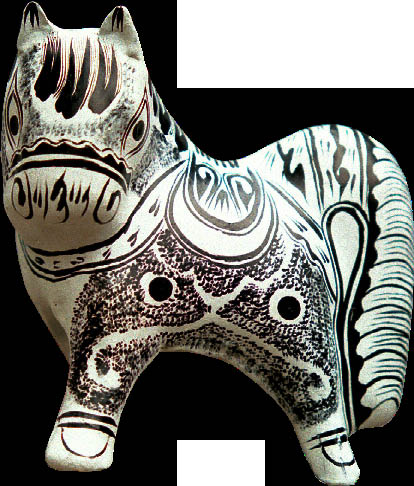|
Fengxiang Clay Figurine
Fengxiang County is in Shaanxi Province in northwest China. It is widely believed that the Fengxiang clay figurine originated in the Ming Dynasty when six barracks of troops were stationed in a village there. When conflicts were resolved, the demobilized soldiers settled down in the village and named it after their military unit – Liuying – meaning "six barracks" in Chinese. Some of the soldiers were craftsmen before they joined the army. They revived their careers as potters in Liuying Village, and were delighted to find deposits of a very special clay unique to the area. However, the clay was too sticky to make pottery, so the craftsmen worked with it until they realized it was an ideal material to make clay sculptures; it didn't crack easily while drying. They mixed the clay with lime powder, animal-hide glue and other materials, shaped the mud and then brought the replicas to life with paint.
The experimental works were brought to village fairs, and to the craftsmen's delight, the figurines sold well. Local residents regarded the sculptures as a protection for a house and a blessing for children, so they were used to ward off evil or given as gifts to youngsters.
 |
|
The image of a Fengxiang clay horse appears on a 2002 stamp. |
Clay figurine making skills were then passed down from generation to generation in Liuying Village and spread to other parts of the county. Soon the area was famed for clay figurine arts. Even today, nearly all the residents in Liuying can show you how to make a clay sculpture.
Images most commonly applied to figurines are flowers, animals and patterns that convey auspicious meanings. Though simple in style, the images are strong, vivid and impressive.
The colors of Fengxiang clay figurines are always in sharp contrast. After a piece of clay is shaped, craftsmen first paint the model white before outlining on it an image in black ink. Bright colors are blended into the design, contained within the outline. The overall effect is cheerful but distinct.
The colors and patterns are quite important in themselves; different meanings are signified, and certain patterns bring good luck. Red often means prosperity while green stands for longevity. A coin pattern calls on good fortune. The peony is a symbol of happiness and good health. A pomegranate expresses the wish for more offspring. There is a long-standing tradition in this area that exactly one month after a baby is born, a grandmother will give him or her a clay tiger, conveying wishes for a healthy and happy life. And these are just a few examples.
The Fengxiang clay figurine is widely recognized today as one of Shaanxi's specialties and is gaining increasing popularity among people in and outside the county.
(To be continued next issue) | 